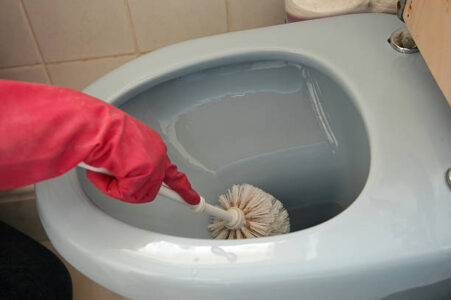We’ve all been there – standing in front of a toilet that just won’t flush properly. It’s one of those household issues that can cause immediate panic. Having a functioning toilet is crucial for maintaining hygiene and comfort in your home. This guide will walk you through everything you need to know about toilet unblocking, from understanding the causes to trying out various unblocking methods and knowing when to call in the pros.
Understanding Toilet Blockages
What Causes a Toilet to Block?
To tackle a blocked toilet effectively, it’s essential to understand what might be causing the problem.
Common Objects
Sometimes, the culprits are objects that shouldn’t be flushed down the toilet in the first place – things like sanitary products, wet wipes, and excessive toilet paper. These items can easily get stuck and cause a blockage.
Pipe Issues
Older homes may have narrow or corroded pipes that are more susceptible to blockages. Additionally, pipes that aren’t aligned properly can hinder the smooth flow of waste.
Build-up of Waste
Over time, waste can build up in the pipes, particularly if the toilet is not flushed properly or if there’s an underlying issue with the plumbing system.
Signs of a Blocked Toilet
Identifying the early signs of a blocked toilet can prevent a minor inconvenience from turning into a major problem.
Slow Draining Water
If you notice that the water in the bowl is draining slowly after a flush, it’s a clear sign of a partial blockage.
Unusual Noises
Gurgling or bubbling noises can indicate that air is trapped in the pipes due to a blockage.
Frequent Overflows
If your toilet overflows frequently, even with normal use, it’s time to investigate a potential blockage.
DIY Methods to Unblock a Toilet
Before you call a plumber, there are several DIY methods you can try to unblock your toilet.
Using a Plunger
Types of Plungers
There are different types of plungers, but for toilets, a flange plunger is most effective. It has an additional rubber flap that creates a better seal.
Proper Plunging Technique
Ensure there’s enough water in the bowl to cover the plunger’s rubber cup. Position the plunger over the drain hole and push down gently, then pull up sharply. Repeat this motion several times to create suction and dislodge the blockage.
Baking Soda and Vinegar Method
Step-by-Step Guide
- Pour a cup of baking soda into the toilet bowl.
- Add a cup of vinegar slowly.
- Let the mixture sit and fizz for about 30 minutes.
- Flush the toilet to see if the blockage has cleared.
Hot Water and Dish Soap
How It Works
Pour a generous amount of dish soap into the toilet bowl followed by a bucket of hot (not boiling) water. Let it sit for a few minutes before attempting to flush. The hot water helps break down the blockage, and the soap acts as a lubricant.
Advanced Unblocking Techniques
If DIY methods fail, you might need to use more advanced techniques.
Plumbing Snake or Auger
Choosing the Right Tool
A plumbing snake or auger is a flexible, long metal coil that can reach deep into the pipes to dislodge blockages. Choose a toilet auger specifically designed for this purpose.
How to Use a Snake
Insert the auger into the toilet bowl and turn the handle clockwise until you feel resistance. Push and twist to break through the blockage, then pull the auger out and flush the toilet.
Enzyme Waste Removal Products
Benefits and Usage
Enzyme-based products are a chemical-free way to break down waste and clear blockages. Pour the recommended amount into the toilet and let it sit overnight. The enzymes will work to dissolve the blockage naturally.
When to Call a Professional
Some blockages are too stubborn for DIY methods and require professional intervention.
Persistent Blockages
If the toilet remains blocked after trying multiple methods, it’s time to call a plumber.
Strange Smells
Unpleasant odors can indicate a deeper problem in the sewage system.
Water Damage
If you notice water damage around the base of the toilet or on the floor, this could be a sign of a severe blockage or a leak.
Preventing Future Blockages
Preventative measures can save you the hassle of dealing with a blocked toilet in the future.
Proper Disposal Practices
Only flush human waste and toilet paper. Dispose of other items, like wipes and sanitary products, in the trash.
Regular Maintenance
Regularly cleaning your toilet and pipes can prevent build-up. Consider using an enzyme cleaner monthly.
Installing Drain Screens
Drain screens can catch hair and other debris, preventing them from causing blockages further down the line.
Conclusion!!
Dealing with a blocked toilet can be a frustrating experience, but with the right knowledge and tools, it’s manageable. By understanding the causes, recognizing the signs, and using effective unblocking methods, you can keep your toilet in top condition. Regular maintenance and proper disposal practices are key to preventing future blockages.
FAQs
Can I use chemical drain cleaners on my toilet?
While chemical drain cleaners can be effective, they can also damage your pipes and harm the environment. It’s better to use enzyme-based products or mechanical methods.
How often should I perform toilet maintenance?
Monthly maintenance, such as using enzyme cleaners and regular cleaning, can help prevent blockages.
What should I do if none of the DIY methods work?
If DIY methods fail, it’s best to call a professional plumber to avoid causing further damage.
Are toilet blockages covered by home insurance?
This depends on your policy. Some home insurance policies cover plumbing issues, but it’s best to check with your provider.
Can tree roots cause toilet blockages?
Yes, tree roots can invade sewer lines and cause significant blockages. If you suspect this, contact a professional plumber.




